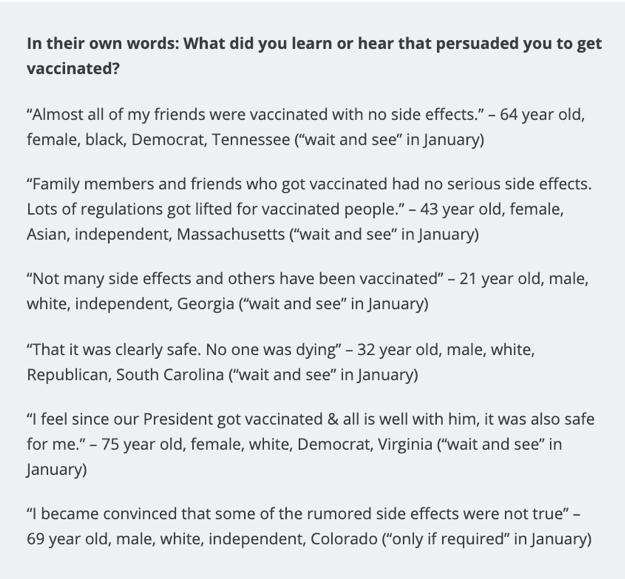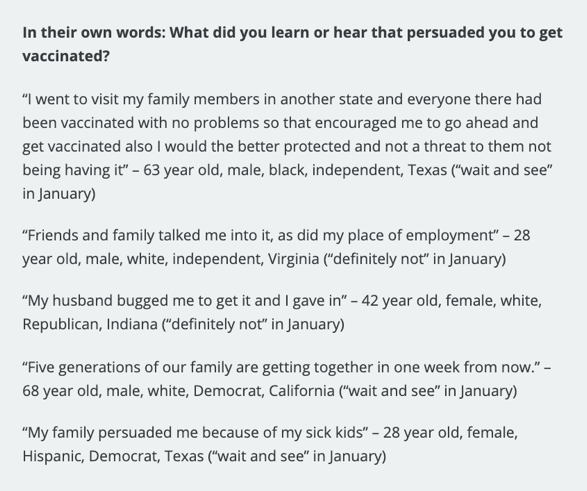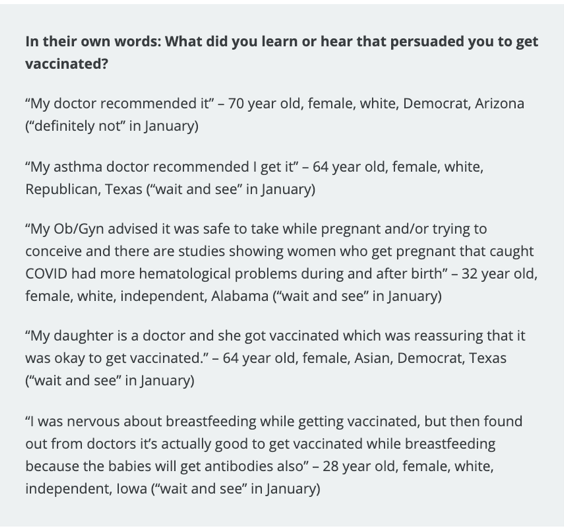 Covering COVID-19 is a daily Poynter briefing of story ideas about the coronavirus and other timely topics for journalists, written by senior faculty Al Tompkins. Sign up here to have it delivered to your inbox every weekday morning.
Covering COVID-19 is a daily Poynter briefing of story ideas about the coronavirus and other timely topics for journalists, written by senior faculty Al Tompkins. Sign up here to have it delivered to your inbox every weekday morning.
President Joe Biden will announce today that all federal civilian employees will either have to be vaccinated or submit to regular COVID-19 tests and comply with social distancing and travel restrictions. You could say that the plan is to make it burdensome enough that people who are not vaccinated will reconsider.
The president will not order workers to vaccinate or be fired. Early this week, the Department of Veterans Affairs told all patient-facing health care workers in the VA system to get vaccinated or they will lose their jobs.
President Biden has not indicated that he will press members of the military to be vaccinated. “There has been no change to our use of the vaccine as a voluntary measure of protection,” Pentagon spokesman John Kirby said in a statement Wednesday. Defense Secretary Lloyd J. Austin III has said he is not comfortable with an order that all members of the military be vaccinated, especially not until the Food and Drug Administration gives final approval for the vaccines, which are currently under emergency approval. That could be a game-changer.
However, Deputy Defense Secretary Kathleen Hicks issued a directive Wednesday that DOD employees and contractors working in states where cases are high should mask up right away.
While masking regulations have come straight from the Pentagon since early 2020, local commanders have had authority to decide who comes on installations and which facilities are open, and to whom, throughout the pandemic, based on local infection statistics.
DoD’s latest data, which hasn’t been updated since July 21, shows that 44 percent of the force ― over 1 million troops ― is fully vaccinated, including both active-duty and reserve troops. Another 228,816 partially vaccinations brings the rate up to 54 percent.
While new COVID-19 infections have slowed since the introduction of the vaccines, service members do continue to be diagnosed. As of July 21, there are 3,600 active cases among troops.
Federal offices and facilities order masks back on after CDC’s newest guidance
The Office of Management and Budget quickly adopted the CDC’s newest guidance on mask-wearing by ordering all federal buildings around Washington, D.C., to start enforcing mask mandates right away.
“In areas of substantial or high community transmission, agencies must require all federal employees, onsite contractors and visitors, regardless of vaccination status, to wear a mask inside of federal buildings,” the Office of Management and Budget said Tuesday evening in an email to agencies. “As of today, that includes the Washington, D.C. area.”
OMB is now asking federal buildings everywhere to post mandatory mask warnings.
Cities and states take action
ABC News summarizes the situation this way:
In some states, local governments have imposed new mask mandates, while in other states, local officials have instead announced new recommendations or reiterated existing recommendations.
In California, while the new mask mandate has only been issued in Los Angeles County, at least ten additional counties across the state are now strongly recommending indoor mask-wearing for all residents — including those who are fully vaccinated. In Massachusetts, several counties and municipalities have brought back mask mandates.
In the cities of Las Vegas and New Orleans, health officials have moved to implement masks for county employees regardless of their vaccination status. Savannah became the first major city in Georgia to reinstate an indoor masks policy for all residents in response to a spike in coronavirus cases in the surrounding counties.
How do I know if I am supposed to wear a mask indoors?
It is reasonable to wonder whether the hottest COVID-19 hot zone states will give two hoots about the CDC’s new mask guidance since not giving a hoot about guidance is why they are hot zones.
Go here. If your county is orange or red (and you will notice how many counties are), that means your county has more than 50 new cases per 100,000 persons in the past seven days or the test positivity rate is greater than 8%. Those warning levels are not new.
The other counties on the maps are at less of a risk currently, but it could change, and probably will.
Does the CDC know something it is not telling us?
One of the key questions at the moment is whether vaccinated people pass the virus to others. The CDC mentioned but did not explain what is in new but unpublished data that seem to say vaccinated people can infect others.
We do not know what the transmission rate is, but whatever it is, it seems to be high enough that the CDC said we all need to mask up if we are in parts of the country with high rates of viral spread.
For the record, the World Health Organization has continued to recommend masking for the vaccinated.
Does the CDC have the power to enforce mask-wearing?
No. Local and state governments have that power. The federal government enforces interstate and federally regulated transportation like ships, planes and trains.
The pushback against forced masks in schools

Masked students wait to go their classrooms on the first day of school at Enrique S. Camarena Elementary School Wednesday, July 21, 2021, in Chula Vista, Calif. The school is among the first in the state to start the 2021-22 school year with full-day, in-person learning. (AP Photo/Denis Poroy)
CNN says 12 of the 20 biggest school systems in the country will require masks this fall. At the same time, eight states banned schools from mandating masks, including Vermont, South Carolina, Iowa, Arkansas, Oklahoma, Texas, Arizona and Utah.
While they cannot require vaccinations, Arkansas, Arizona and Oklahoma officials say plan to encourage school students and staff to wear masks and get vaccinated (but will not require proof of vaccination). CNN reports:
Of the 20 biggest US school districts, 12 are requiring masks for students when the school year begins.
The nation’s three largest school districts — New York City, Los Angeles and Chicago — will require masks in schools. Clark County Public Schools in Nevada, the fifth largest district in the country, decided to require masks after the CDC’s new guidance.
In Jefferson County, Kentucky, masks will only be required to be worn by students who are unvaccinated.
Two districts in North Carolina, Charlotte-Mecklenburg and Wake County, will only require masks until the end of July — at which point a new decision will be made before the school year begins.
Protesters pushed back on the CDC’s recommendation that students and teachers in schools in every state wear masks when they return to the classroom in the coming weeks.
In Ft. Lauderdale, Florida, protesters got so rowdy that the school board adjourned a meeting about masks.
Miami-Dade County said it will require masks on school buses but is still deciding whether to require them in classrooms.
South Carolina education officials say they cannot follow the CDC’s guidelines because of a newly passed law that forbids requiring tax-supported schools from requiring masks.
In Pennsylvania, the governor said he will not require masks in schools while the state’s education officials said they recommend masks.
What makes vaccine skeptics change their minds?

In this July 22, 2021, file photo, a health care worker fills a syringe with the Pfizer COVID-19 vaccine at the American Museum of Natural History in New York. (AP Photo/Mary Altaffer, File)
The Kaiser Family Foundation wanted to know what motivates people who were opposed to taking the COVID-19 vaccine to change their minds and obtained some insightful data.
Here are some of the main motivators (which I edited for length). You really should go to the KFF website to pull the data to develop this story. It might also give you insight into what messages resonate with people who need to hear it most.
- One-fifth of adults (21%) now report being vaccinated after saying in January they planned on waiting to get vaccinated, would only get it if required, or would definitely not get vaccinated.
- Many of these individuals noted the role of their friends and family members as well as their personal doctors in persuading them to get a vaccine. Seeing their friends and family members get vaccinated without serious side effects, talking to family members about being able to safely visit, and conversations with their personal doctors about their own risks were all persuasive factors for these individuals.

(Kaiser Family Foundation)
- A small but meaningful share also say the easing of restrictions for vaccinated people was a factor in their decision to get a vaccine.

(Kaiser Family Foundation)
- When asked to name the feeling that best describes how they feel now that they have been vaccinated, nearly a quarter of vaccinated adults offer responses around feeling safe (24%) and relieved (22%). Other positive feelings reported were freedom, confidence, and more certainty that if they did get COVID-19 it would be less serious or they were less likely to die from it.
- Conversations with family members and friends have played a major role in persuading people to get vaccinated. 17% of adults who are now vaccinated (after saying in January they planned on waiting to get vaccinated, would only get it if required, or would definitely not get vaccinated) say they were persuaded to do so by a family member and 5% say they were persuaded by a friend.

(Kaiser Family Foundation)
- Others cite protecting friends and family members as the main reason for getting vaccinated and others offer being able to see their friends and family members as well as family pressure or encouragement as the main reasons why they chose to receive a vaccine.
- When asked what would motivate them to get vaccinated against COVID-19, most in the “wait and see” group say they just want more time to see how the vaccine affects others who have already gotten it.
The Kaiser polling shows that a substantial number of people are concerned about the side effects of the vaccination. They say they can’t afford to be sick for a few days. They say they want to wait until the vaccine has been in use for a year, then they will consider it.
Another research project involving vaccine skeptics by Echelon Insights involved millions of social media posts, as well as tracking polls. It even takes a global view of why people turn down vaccines. It found that among vaccine skeptics or opponents, one of the most persuasive messages would be that former President Donald Trump took the vaccine and supported its rapid development.
UK mystified by a big drop in COVID cases

A view of the newly built “Marble Arch Mound” after it was opened to the public next to Marble Arch in London, Tuesday, July 27, 2021. The temporary installation commissioned by Westminster Council and designed by architects MVRDV has been opened as a visitor attraction to try and entice shoppers back to the adjacent Oxford Street after the coronavirus lockdowns. (AP Photo/Matt Dunham)
As you read this today, authorities in the United Kingdom are trying to figure out why COVID-19 cases are dropping fast rather than climbing, as expected.
New infections are today 36% less than just a week ago. I notice that testing also dropped 14% in that period and there is a 23% increase in patients being admitted to hospitals.
The Washington Post suggests three other possibilities. One of them would not be good news:
- Test-and-trace might be working. Last week, almost 620,000 people were pinged by a National Health Service app in England and Wales telling them to quarantine after exposure to the virus.
- It is also possible that people have stopped getting tested — because if they test positive, even if they are fully vaccinated, they are asked to quarantine for 10 days, even if they are about to travel abroad for their holidays.
- Or maybe Britain has reached an immunity threshold. More than 70 percent of adults here are fully vaccinated, and 88 percent have had a first dose — one of the best vaccine uptakes in the world. Among those who remain unvaccinated, many have had covid or asymptomatic infection.
We’ll be back tomorrow with a new edition of Covering COVID-19. Are you subscribed? Sign up here to get it delivered right to your inbox.







